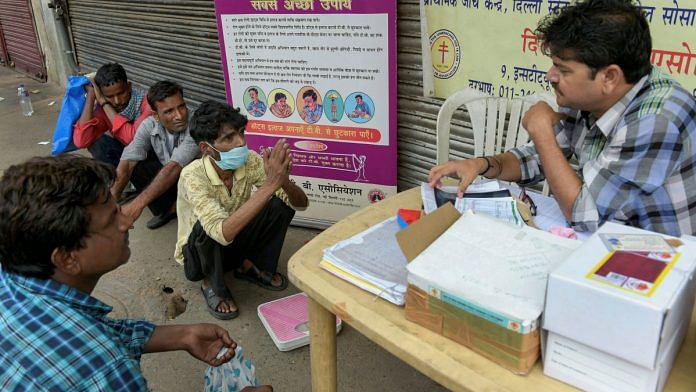New Delhi: India recorded the largest dip of 41 per cent in global tuberculosis reporting during the Covid pandemic, revealed the latest report on the disease by the World Health Organization (WHO).
According to the report released in Geneva Thursday, India, Indonesia and Philippines recorded the highest drop in TB reporting between 2019 and 2020.
“The countries that contributed most to the global drop between 2019 and 2020 were India (41 per cent), Indonesia (14 per cent), the Philippines (12%) and China (8 per cent); these and 12 other countries accounted for 93 per cent of the total global drop of 1.3 million,” said the report titled Global Tuberculosis Report 2021.
India also accounted for 38 per cent of global TB deaths among HIV-negative people in 2020 and for 34 per cent of the combined total number of TB deaths in HIV-negative and HIV-positive people.
For India, the TB case fatality ratio (estimated mortality/estimated incidence) went from 17 per cent in 2019 to 20 per cent in 2020. The report also noted that updates in the Indian TB numbers are expected soon after the completion of the country’s first-ever national TB prevalence survey.
According to the WHO report, an estimated 9.9 million people fell ill with TB in 2020. Globally, the TB incidence rate fell by 11 per cent between 2015 and 2020 (from 142 to 127 new cases per 100,000 population), including a reduction of 1.9 per cent compared with 2019.
Further, the number of people newly diagnosed with TB and reported to national governments globally dropped from 7.1 million in 2019 to 5.8 million in 2020. Six countries — India, Mozambique, Nigeria, South Africa, Uganda and Zambia — collectively accounted for 74 per cent of those started on treatment in 2020.
Tuberculosis is widely regarded as India’s longest lasting epidemic that kills, according to government estimates, about 1,400 people every day.
The widespread prevalence of TB in the country makes one of the most commonly used tests for the disease — the Mantoux test, which involves injecting the antigen into the skin to check for reactions — not being preferred in India. The presence of the bacteria in the body even when a person is asymptomatic, makes the test prone to false positives.
A slew of measures over the last few years ensured that India started tracking more TB cases than ever before to put an end to the chain of transmission. But since the Covid pandemic started in March 2020, all those hard earned gains in TB testing and tracking have been lost.
Also read: 2021’s Covid outbreak in Delhi shows herd immunity against Delta difficult, study says
TB second most fatal infectious disease after Covid
The global report has predicted that the disruptions in both the demand and the supply side of TB treatment may have catapulted the bacterial infection to the second most fatal infectious disease in the world.
“The latest year for which WHO has published estimates of global deaths by cause is 2019… TB was the 13th leading cause of death worldwide and the top cause from a single infectious agent. In 2020, it is anticipated that TB will rank as the second leading cause of death from a single infectious agent, after COVID-19,” the report said.
Globally the goal is to end TB by 2030 but India, thanks to a personal commitment made by Prime Minister Narendra Modi, aims to do so by 2025.
The ‘End TB Strategy’ milestones for reductions in TB disease burden by 2020 were a 35 per cent reduction in the number of TB deaths, and a 20 per cent reduction in the TB incidence rate, compared with levels in 2015.
In actual terms, the reduction in the number of TB deaths between 2015 and 2020 was only 9.2 per cent.
“Progress achieved up to 2019 (a 14 per cent reduction from 2015 to 2019 and a 41 per cent reduction from 2000 to 2019) was compromised by the increase in TB deaths in 2020 that resulted from disruptions to diagnosis and treatment caused by the COVID-19 pandemic,” the report said.
(Edited by Amit Upadhyaya)
Also read: Why tiny Mizoram has emerged as Covid hotspot with 17% positivity rate as rest of India sees drop



